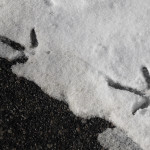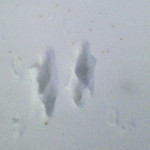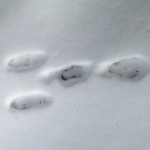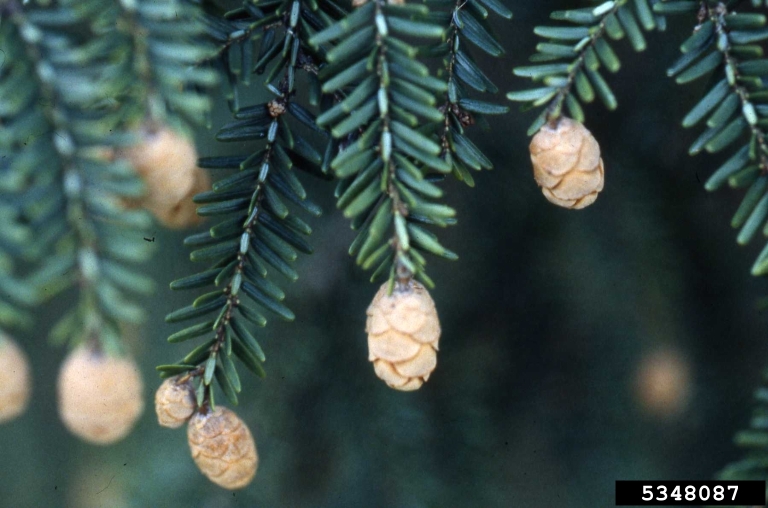When it snows, something magical happens: you can peek into the lives of many secretive creatures by examining the tracks they leave behind. Tracking is about more than just following an animal’s trail. It’s about discovering the natural world around you while sharpening your powers of observation.
Like any skill, tracking takes practice. Here are a few basic things to keep in mind:
- Snow conditions. Animal prints can look different depending on their age and the condition of the snow. Old prints in melting snow, for example, can look much larger. If snow has fallen on a track, obscuring details, focus on the pattern of the whole trail.
- The shape of the prints. Are they round or oval? Are some of them bigger than others (since many animals have different-sized front and hind paws)? How many toes can you count?
- The pattern of the prints. For example, a squirrel that hops between trees leaves a box-like pattern of four prints. A bounding weasel may leave a string of two side-by-side prints.
- Size. Grab a ruler and measure your discoveries. A good tracking book will help you use these measurements to distinguish between the tracks of similar species.
- Habitat. Clues from the environment may enable you to figure out which animal left the trail and what it was doing. For example, you’re more likely to find red squirrels in conifers and gray squirrels in deciduous trees. Was the animal wandering all about or just quickly passing through?
- Other signs. Don’t just look for prints—can you see any chewed nuts, bark, or twigs? Any signs of digging?
- Keep your distance. Winter is a challenging time for wildlife. Be careful not to stress animals and don’t approach their homes or resting sites.
Now that you know the basics, let’s identify some common tracks you may find:
 White-tailed Deer
White-tailed Deer
These hoofed creatures leave pointed prints with a split down the middle. Deer also have two toes higher on the leg called dewclaws that sometimes appear in the print (see them to the left of the photo). The two largest pointy hooves point in the direction of travel; this deer was headed to the right.
 Wild Turkey
Wild Turkey
Big birds leave large tracks, and turkey prints can be three to five inches long. They look a bit like dinosaur footprints! Note the three widely-spread toe prints pointing forward. There’s also a tiny toe print pointing backward—can you see it?
 Gray Squirrel
Gray Squirrel
Here’s a case where the pattern of the prints is more useful than any individual print. When a squirrel hops, it puts down its smaller front paws side by side first (the shorter dashes) then puts down its larger hind paws directly in front (the longer dashes).
 Eastern Cottontail Rabbit
Eastern Cottontail Rabbit
Rabbit tracks look a bit like squirrel tracks, but the two smaller front feet are placed one in front of the other, rather than side by side. This animal was traveling from right to left.
Learn More
This post just scratches the surface of animal track identification. It’s a complicated art and science; experts can uncover amazingly detailed stories from clues like stray hairs and places where tracks from two species meet. Find out more by attending one of our tracking programs.
Also, browse a selection of guides for all ages and skill levels at the Audubon Shop in Lincoln, including Big Tracks, Little Tracks: Following Animal Prints for 3-6 year olds, the Science on a Tracking Expedition kit, which is packed with games and activities, and the North Woods Animal Tracks Guide, a weatherproof set of ID cards on a keychain.
What natural secrets have you uncovered through tracks?


 Of all the evergreens in the winter woods, eastern hemlocks are the friendliest.
Of all the evergreens in the winter woods, eastern hemlocks are the friendliest. Hemlock groves are magical to non-human animals, too. Because hemlock branches hold so much snow, snow depths beneath the trees are significantly lower. Deer often bed down underneath these trees, taking advantage of shallower snow and sheltering branches. Treat yourself to an early morning snowshoe or hike. You may be able to follow deer tracks from hemlock to hemlock, finding packed snow outlining the shape of a deer underneath each one.
Hemlock groves are magical to non-human animals, too. Because hemlock branches hold so much snow, snow depths beneath the trees are significantly lower. Deer often bed down underneath these trees, taking advantage of shallower snow and sheltering branches. Treat yourself to an early morning snowshoe or hike. You may be able to follow deer tracks from hemlock to hemlock, finding packed snow outlining the shape of a deer underneath each one. Sadly, our Massachusetts hemlocks are threatened by
Sadly, our Massachusetts hemlocks are threatened by